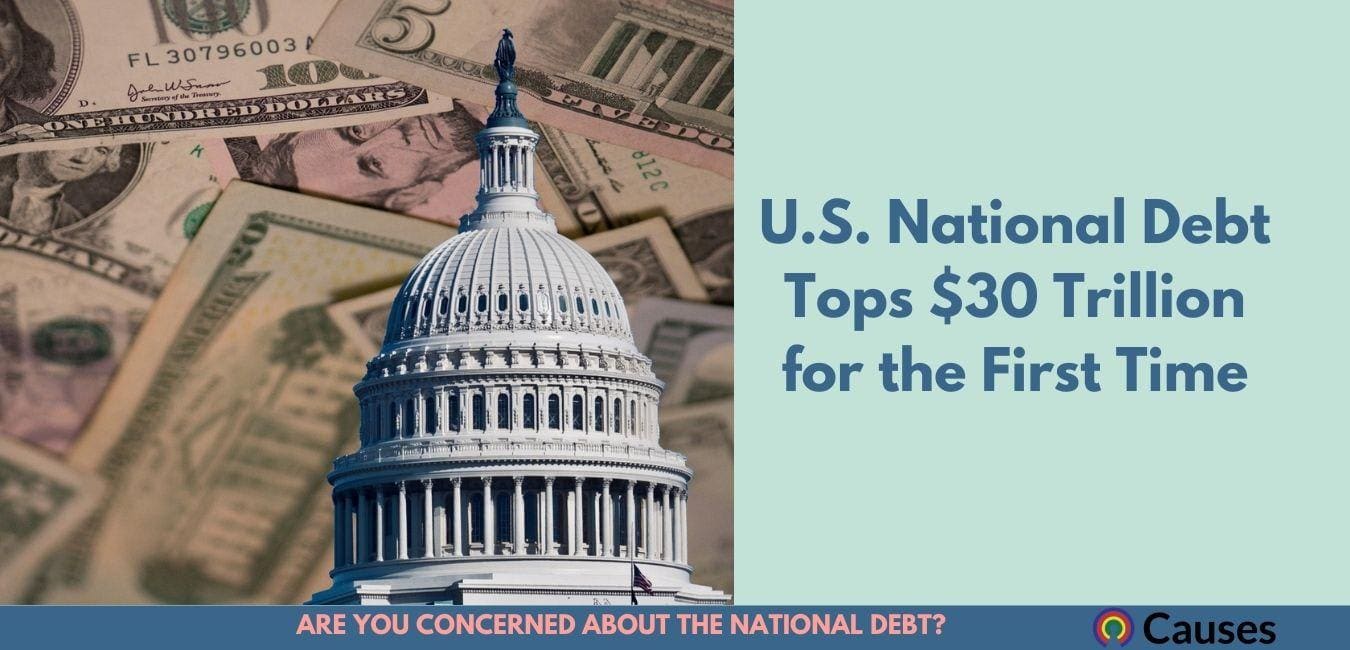
U.S. National Debt Tops $30 Trillion for the First Time - Are You Concerned?
Are you concerned about the national debt?
Written by Eric Revell, Countable News
What’s the story?
- The total U.S. national debt surpassed $30 trillion for the first time ever according to data released by the Treasury Dept. this week.
What is the national debt?
- The national debt is a term that refers to how much the U.S. government owes its creditors, who effectively lend money to the government when it runs a budget deficit (e.g. spending exceeds tax revenue) by purchasing debt instruments such as Treasury bonds that earn interest over time.
- The federal government’s gross debt (or the total public debt outstanding) exceeded $30 trillion on Monday for the first time ever. Gross debt is a figure that includes both the debt held by the public and intragovernmental holdings ― which is made up of debt held in government trust funds, revolving funds, and special funds.
- The debt held by the public is a figure which includes debt held by both the U.S. public and foreign entities, which surpassed $23.5 trillion as of this week.
- Debt held by the public is more commonly reported than the gross national debt, particularly in connection to the size of the economy in terms of gross domestic product (GDP). According to the Federal Reserve, U.S. GDP reached $23.9 trillion in the fourth quarter of 2021, which means debt held by the public is roughly 98% of GDP.
How does the national debt grow or shrink?
- Budget deficits increase the national debt, and budget surpluses reduce the national debt. In July 2021, the Congressional Budget Office (CBO) estimated that in fiscal year 2022 the federal government would run a deficit of about $1 trillion and debt held by the public would top 100% of GDP.
- The federal government currently has a structural budget deficit due to growth in mandatory spending on programs such as Medicare and Social Security, which are linked to the aging population; Medicaid, which provides healthcare to low-income individuals; and the rising cost of servicing the interest on the national debt.
- The CBO’s projection from last summer for FY2022 estimated about $4 trillion in spending on mandatory programs, a figure which includes $1.5 trillion in spending on major healthcare programs like Medicare and Medicaid; $1.2 trillion in spending on Social Security and related programs; plus $300 billion in net interest expense on the national debt, $227 billion on federal retirement programs, $166 billion on veterans’ programs, and $379 billion in spending on other mandatory programs. Once offsetting receipts are factored in, net mandatory spending totals about $3.6 trillion in FY2022.
- To a lesser extent, the federal government’s discretionary spending ― the annual appropriations Congress provides to agencies like the Dept. of Defense or Education Dept. ― contributes to the debt as well, but discretionary appropriations have only accounted for about $1.5 trillion in federal spending in recent years and have grown at a slower rate than mandatory spending.
- The CBO’s July 2021 forecast for discretionary spending in FY2022 estimated about $1.6 trillion in spending, including $899 billion on non-defense programs and $751 billion on defense.
- During the COVID-19 pandemic, federal discretionary spending spiked to provide economic relief to the American public and impacted businesses, which resulted in record-setting deficits of more than $3.1 trillion in FY2020 and $2.8 trillion in FY2021.
RELATED READING
- Federal Deficit Tops $2.1 Trillion in FY2021 Through May, Outpacing FY2020’s Record-Setting Deficit (6/28/21)
- CBO Projects U.S. National Debt to Exceed GDP in 2021 for First Time Since the End of World War II (2/19/21)
- CBO Projects $3.1 Trillion Federal Deficit in FY2020 Amid Coronavirus Pandemic (10/17/20)
- Federal Tax Revenue Hits All-Time High, So Why is the Deficit Growing? (11/8/19)
- Japan Now Owns More of America’s Debt Than China ― Who Else Owns the National Debt? (8/29/19)
- CBO Budget Forecast Projects Larger Deficits After Congress Increases Spending (8/22/19)
- What Happens to the Debt if Congress Doesn’t Cut Spending or Raise Taxes? (5/4/19)
- Who Owns the U.S. National Debt? (4/26/19)
- CBO: Programs for the Elderly to Approach 50% of Federal Noninterest Spending (4/23/19)
- CBO: Medicare, Social Security, and Debt Interest Driving Deficits (1/30/19)
(Photo Credit: iStock.com / Douglas Rissing)